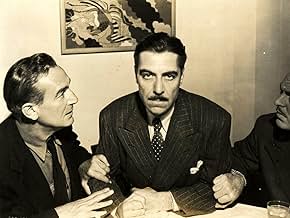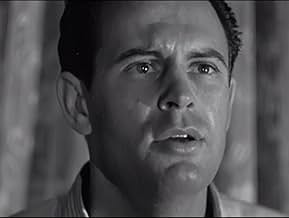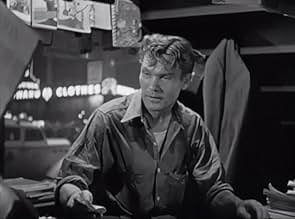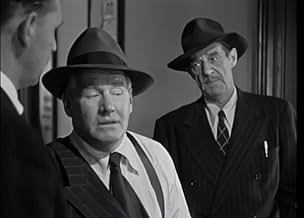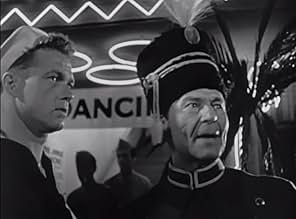ÉVALUATION IMDb
6,8/10
2,3 k
MA NOTE
Le dernier jour de sa permission à New-York, un jeune marin se réveille avec une grosse somme d'argent en poche. Il l'a pris chez une femme avec laquelle il a bu, mais ne se souvient plus de... Tout lireLe dernier jour de sa permission à New-York, un jeune marin se réveille avec une grosse somme d'argent en poche. Il l'a pris chez une femme avec laquelle il a bu, mais ne se souvient plus de rien.Le dernier jour de sa permission à New-York, un jeune marin se réveille avec une grosse somme d'argent en poche. Il l'a pris chez une femme avec laquelle il a bu, mais ne se souvient plus de rien.
- Prix
- 1 nomination au total
Ernie Adams
- Waiter
- (uncredited)
Fred Aldrich
- Beefy Nightclub Guest
- (uncredited)
Walter Bacon
- Commuter
- (uncredited)
John Barton
- One-Legged Man
- (uncredited)
Billy Bletcher
- Waiter
- (uncredited)
Histoire
Le saviez-vous
- AnecdotesJoe Sawyer's character of washed-up baseball player Babe Dooley was based on Chicago Cubs hitting great Hack Wilson whose alcoholism led to his steep professional and personal decline.
- GaffesAt the end, the main characters exit the 8th Police Precinct. It is night, and the streets are deserted. Yet when June and Alex drive away in the police car, it can be seen through the back window of the vehicle that the streets are bustling with activity, cars, and people, and it's bright and sunny.
- Citations
June Goffe: If you hear a peculiar noise, it's my skin creeping.
- ConnexionsFeatured in Noir Alley: Deadline at Dawn (2017)
Commentaire en vedette
Deadline at Dawn (1946)
If you can overcome, or overlook, the slightly stilted plot and the improbability of the events (in an O'Henry kind of way, if you know his clever short stories, though the actual writer is Clifford Odets, whose politics are not very visible), you'll be able to catch the really fine acting and directing here. And the nicely felt night crime drama that is really just a beautiful sappy love story (the best kind). The cast is small, the plot twists unreasonable but still enchanting, and the effect, in the end, is tightly wound.
While you might think the murder is the central premise (and it's key, for sure), or the sailor's blackout is the main event (and it isn't, really), you will eventually see it's the sailor himself, his utter innocence, that is both the core of the film and the driving force. This is the Odets part of the writing, character driven, and the sailor, through some effect of drinking we assume, has had a brief blackout, and he comes to his senses on the streets of New York with a lot of cash in his pocket. He's troubled, but we sympathize. Then a woman he was with is found dead. Still, this sailor is such the definition of innocence, there's no doubt--almost no doubt--that someone else did it. But who? And how can he defend himself?
Enter Susan Hayward, playing at first a kind of professional dance companion (the innocent side of prostitution, and a good match for our man). After work, she wants to help him because he's so clearly a good person, and then a cabbie strangely gets involved, too, sucked into the idea that justice will go wrong if the real killer can't be found. The dead woman had a couple of unsavory friends, and these two get into the plot in stages, and what we end up with is half a dozen clearly defined people all fighting for some small piece of personal clarity and internal well being.
It helps that all the actors are first rate small time contributors (Hayward is the one star, and is terrific). It also helps that the whole scenario is limited in time and space, so we get to feel like we are there, in New York, in this small neighborhood at night. It's great stuff on that level alone. The director? It's his one and only film. But the cinematographer was an old pro at the peak of his career, Nicholas Musuraca, who did a whole slew of noirs and dramas, some worth seeing just for the photography ("Spiral Staircase" comes to mind, but see the IMDb list). So whatever the small time credentials of much of the cast, there is some seriousness here that won't let go.
If the plot is a little preposterous, it's only because it's trying to package things too neatly. The writing is first rate, beyond plot structure, with some classic quotable lines that are either film noir staples or philosophical nuggets (the latter from the cabby, in particular). A film that would reward a second viewing just for the details of dialog and camera-work.
If you can overcome, or overlook, the slightly stilted plot and the improbability of the events (in an O'Henry kind of way, if you know his clever short stories, though the actual writer is Clifford Odets, whose politics are not very visible), you'll be able to catch the really fine acting and directing here. And the nicely felt night crime drama that is really just a beautiful sappy love story (the best kind). The cast is small, the plot twists unreasonable but still enchanting, and the effect, in the end, is tightly wound.
While you might think the murder is the central premise (and it's key, for sure), or the sailor's blackout is the main event (and it isn't, really), you will eventually see it's the sailor himself, his utter innocence, that is both the core of the film and the driving force. This is the Odets part of the writing, character driven, and the sailor, through some effect of drinking we assume, has had a brief blackout, and he comes to his senses on the streets of New York with a lot of cash in his pocket. He's troubled, but we sympathize. Then a woman he was with is found dead. Still, this sailor is such the definition of innocence, there's no doubt--almost no doubt--that someone else did it. But who? And how can he defend himself?
Enter Susan Hayward, playing at first a kind of professional dance companion (the innocent side of prostitution, and a good match for our man). After work, she wants to help him because he's so clearly a good person, and then a cabbie strangely gets involved, too, sucked into the idea that justice will go wrong if the real killer can't be found. The dead woman had a couple of unsavory friends, and these two get into the plot in stages, and what we end up with is half a dozen clearly defined people all fighting for some small piece of personal clarity and internal well being.
It helps that all the actors are first rate small time contributors (Hayward is the one star, and is terrific). It also helps that the whole scenario is limited in time and space, so we get to feel like we are there, in New York, in this small neighborhood at night. It's great stuff on that level alone. The director? It's his one and only film. But the cinematographer was an old pro at the peak of his career, Nicholas Musuraca, who did a whole slew of noirs and dramas, some worth seeing just for the photography ("Spiral Staircase" comes to mind, but see the IMDb list). So whatever the small time credentials of much of the cast, there is some seriousness here that won't let go.
If the plot is a little preposterous, it's only because it's trying to package things too neatly. The writing is first rate, beyond plot structure, with some classic quotable lines that are either film noir staples or philosophical nuggets (the latter from the cabby, in particular). A film that would reward a second viewing just for the details of dialog and camera-work.
- secondtake
- 24 juin 2011
- Lien permanent
Meilleurs choix
Connectez-vous pour évaluer et surveiller les recommandations personnalisées
- How long is Deadline at Dawn?Propulsé par Alexa
Détails
- Date de sortie
- Pays d’origine
- Langues
- Aussi connu sous le nom de
- En el nombre del amor
- Lieux de tournage
- Backlot, 20th Century Fox Studios - 10201 Pico Blvd., Century City, Los Angeles, Californie, États-Unis(New York night street scenes)
- société de production
- Consultez plus de crédits d'entreprise sur IMDbPro
- Durée1 heure 23 minutes
- Couleur
- Rapport de forme
- 1.37 : 1
Contribuer à cette page
Suggérer une modification ou ajouter du contenu manquant

Lacune principale
By what name was Deadline at Dawn (1946) officially released in India in English?
Répondre
